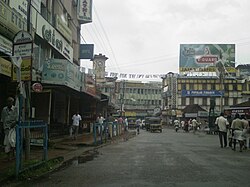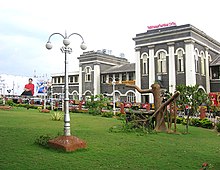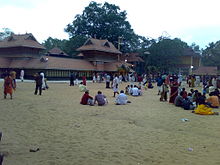| Pathanamthitta district | ||||||||||||||||||||||||||||||||||||||||||||||||||||||||||||||||||||||||||||||||||||||||||||||||||||||||||||||||
|---|---|---|---|---|---|---|---|---|---|---|---|---|---|---|---|---|---|---|---|---|---|---|---|---|---|---|---|---|---|---|---|---|---|---|---|---|---|---|---|---|---|---|---|---|---|---|---|---|---|---|---|---|---|---|---|---|---|---|---|---|---|---|---|---|---|---|---|---|---|---|---|---|---|---|---|---|---|---|---|---|---|---|---|---|---|---|---|---|---|---|---|---|---|---|---|---|---|---|---|---|---|---|---|---|---|---|---|---|---|---|---|---|
| — district — | ||||||||||||||||||||||||||||||||||||||||||||||||||||||||||||||||||||||||||||||||||||||||||||||||||||||||||||||||
 | ||||||||||||||||||||||||||||||||||||||||||||||||||||||||||||||||||||||||||||||||||||||||||||||||||||||||||||||||
| Coordinates: 9.27°N 76.78°ECoordinates: 9.27°N 76.78°E | ||||||||||||||||||||||||||||||||||||||||||||||||||||||||||||||||||||||||||||||||||||||||||||||||||||||||||||||||
| Country | India | |||||||||||||||||||||||||||||||||||||||||||||||||||||||||||||||||||||||||||||||||||||||||||||||||||||||||||||||
| State | Kerala | |||||||||||||||||||||||||||||||||||||||||||||||||||||||||||||||||||||||||||||||||||||||||||||||||||||||||||||||
| Headquarters | Pathanamthitta | |||||||||||||||||||||||||||||||||||||||||||||||||||||||||||||||||||||||||||||||||||||||||||||||||||||||||||||||
| Government | ||||||||||||||||||||||||||||||||||||||||||||||||||||||||||||||||||||||||||||||||||||||||||||||||||||||||||||||||
| • District Collector | P. Venugopal | |||||||||||||||||||||||||||||||||||||||||||||||||||||||||||||||||||||||||||||||||||||||||||||||||||||||||||||||
| Area | ||||||||||||||||||||||||||||||||||||||||||||||||||||||||||||||||||||||||||||||||||||||||||||||||||||||||||||||||
| • Total | 2,642 km2 (1,020 sq mi) | |||||||||||||||||||||||||||||||||||||||||||||||||||||||||||||||||||||||||||||||||||||||||||||||||||||||||||||||
| Population | ||||||||||||||||||||||||||||||||||||||||||||||||||||||||||||||||||||||||||||||||||||||||||||||||||||||||||||||||
| • Total | 1,231,577 | |||||||||||||||||||||||||||||||||||||||||||||||||||||||||||||||||||||||||||||||||||||||||||||||||||||||||||||||
| • Density | 467/km2 (1,210/sq mi) | |||||||||||||||||||||||||||||||||||||||||||||||||||||||||||||||||||||||||||||||||||||||||||||||||||||||||||||||
| Languages | ||||||||||||||||||||||||||||||||||||||||||||||||||||||||||||||||||||||||||||||||||||||||||||||||||||||||||||||||
| • Official | Malayalam, English | |||||||||||||||||||||||||||||||||||||||||||||||||||||||||||||||||||||||||||||||||||||||||||||||||||||||||||||||
| Time zone ISO 3166 code Official website | IST (UTC+5:30) IN-KL- Pathanamthitta.gov.in | |||||||||||||||||||||||||||||||||||||||||||||||||||||||||||||||||||||||||||||||||||||||||||||||||||||||||||||||
EtymologyThe district's name is a combination of two Malayalam words pathanam and thitta, which together mean 'array of houses on the river side'. The district capital is located on the banks of the river Achankovil.HistoryIt is presumed that the regions that form the district were formerly under the Pandalam reign, which had connections with the Pandya kingdom. When Pandalam was added to the princely state Travancore in 1820, the region came under Travancore administration.In 1930's, the Pathanamthitta district was the center of the "Reunion Movement" within the Malankara Orthodox Church which lead to part of that denomination joining the Catholic Church as the Syro-Malankara Catholic Church. The district was formed on November 1, 1982 in the interest of speeding up development. The formation was done by incorporating various portions of the erstwhile Kollam, Alappuzha and Idukki districts. While the taluks Pathanamthitta, Adoor, Ranni, Konni and Kozhencherry were taken from Kollam district, Thiruvalla and Mallappally were taken from Alappuzha district. In 2010, the area of the Pathanamthitta district became the Eparchy of Pathanamthitta for the Syro-Malankara Catholic Church, splitting off from the Major Archieparchy of Trivandrum. GeographyPathanamthitta is a landlocked district, located at 9°16′N 76°47′E, spanning over an area of 2,637 square kilometres (1,018.15 sq mi). The district is bordered by the districts Kottayam and Idukki in the north, Alappuzha in the west, Kollam in the south. To the east it has border with the Tamil Nadu state.The district can be divided into three natural geographical regions: the highland, the midland and the lowland. The highland stretches through the Western Ghats, where the hills are tall and covered with thick forests. Western Ghats maintains an average altitude of around 800 m. It descends to the smaller hills of midland in the centre and finally to the lowland. The lowland with its abundance of coconut trees, lies along the western borders of Alappuzha district. Climate
ForestPathanamthitta district has a reserve forest(ranni reserve and konni reserve) area of 1,385.27 square kilometres (534.86 sq mi). This is approximately 50% of the total district area. The forest area can broadly be classified as evergreen, semi-evergreen and moist deciduous. The forest is the main source of raw materials for wood based industrial units. Timber is the most important produce.RiversThree important rivers flow through the district. These rivers originate from various mountains of the Western Ghats mountain range. The Pamba (176 km/109 mi) which is the third longest river in kerala, has its origin in Pulachimala. The Achankovil river (128 km/80 mi) originates from Pasukida Mettu, and Manimala river (90 km/56 mi) originates from the Thattamalai hills. A small portion of Kallada river also falls in the southern border of the district. Pamba and Achankovil rivers together drain more than 70% of the total area of Pathanamthitta.One third of the electricity produced in the State comes from this district. The Sabarigiri Hydroelectric project situated at the Pamba basin and the Kakkad Electricity project functions in this district. The abundant water resources are also utilized for irrigation purpose through the Kallada and Pamba irrigation projects. EconomyAgricultureAgriculture is the main occupation of the people. About 75% people are dependent on this sector. Rubber is the most important crop, with its plantations covering over 478 square kilometres (185 sq mi). The hilly terrain coupled with high humidity makes the region suitable for rubber plantations. Paddy is the most important crop cultivated in the wet lands. Tapioca and pulses are the important dry land crops. Other major crops are coconut, banana, pepper and ginger. In certain areas cashew, pineapple, sugarcane, cocoa and other tree spices are cultivated. The land available for cultivation is less since sizeable area of the district is reserve forest.
FisheriesPathanamthitta district has a unique position in the inland fisheries map of Kerala state with its freshwater resources like rivers, reservoirs, streams, ponds, quarries and paddy fields. The fisheries activities in this region started with the establishment of a Fresh Water Survey Station. The district has an Ornamental Fish Breeding resource centre and a National Fish Seed Farm. There are 2444 fishermen depending on this sector for their livelihood.Pathanamthitta district has tremendous potential in fish culture sector. For the development of piscine culture activities a Fish Farmers Development Agency(F.F.D.A.) was constituted during the year 1990. The agency provide technical as well as financial assistance to the farmers. The ongoing schemes of F.F.D.A. are assistance to new pond construction, pond reclamation, supply of fish seed, feed, medicine towards input, integrated farming and establishment of mini hatcheries. IndustryPathanamthitta is a less industrialized district of Kerala. As of March 31, 2006, there are 13,898 registered Small Scale Industries (SSI), employing 46,421 people. There are also 378 workers employed in the handloom sector. There are three Mini Industrial Estates in the district with the State government declaring 8.5 hectares of area as development plot. District Industries Centre distributes the land to needy entrepreneurs on request. 14.48 hectares of land has been transferred to KINFRA and five acres of land has been transferred to SIDCO for industrial parks. Green channel committee has been set up to help entrepreneurs get help in obtaining licenses, clearances, electricity, water connection, without delay.AdministrationThe district headquarters is at Pathanamthitta town. The district administration is headed by the District Collector. He is assisted by five Deputy Collectors holding charges of general matters, revenue recovery, land acquisition, land reforms and election.
Under the three tier system of panchayat in rural areas, Pathanamthitta has one district panchayat, 9 block panchayat and 53 grama panthayats. The headquarters of the district panchayat is also at Pathanamthitta. Under the single tier system of municipality in urban areas, Adoor, Pathanamthitta and Thiruvalla are the 3 municipalities the district has. Kozhencherry is a census town. Pandalam, Ranni, Konni, Mallapally, Koipuram-Kumbanad, etc. are other major towns. As per the Delimitation of Parliamentary and Assembly Constituencies Order, 2008, Pathanamthitta has five Assembly constituencies, down from eight. However, the district was unified into a single Parliamentary constituency, thus contributing a seat to the Lok Sabha. The Pathanamthitta parliamentary constituency is formed by including all the five Assembly constituencies of the district along with two other Assembly constituencies in the neighboring Kottayam district. Congress, Kerala Congress, and the CPM/CPI are the main political parties. TransportSome portion of National Highway 220 (NH220) passes through Tiruvalla. SH 07 and SH 08 are the two major State highways providing connectivity to other towns and districts. SH 07, also known as T. K. Road, passes only through Pathanamthitta. SH 08 also known as Main Eastern Highway, is the second longest state highway of Kerala. It connects the townships of Punalur in Kollam district and Muvattupuzha in Ernakulam district.The Kerala Public Work Department (P.W.D) maintains the all the roads in the district, including the village roads. As of 2005, P.W.D. maintains about 1,596 kilometres (992 mi) of road in the district.There is a good connectivity of State transport, K.S.R.T.C., on the T.K. Road. However, on other roads and especially towards the eastern side, the State transport service is less frequent. Here, private bus operators facilitate the transportation needs. The K.S.R.T.C. has three major depots in the district. From Pathanamthitta, there are Inter State Services to Coimbatore and Tenkasi. Tiruvalla (TRVL) is the only Railway Station within the district. Express trains to Trivandrum, Cochin, Chennai, Mangalore, Mumbai, Hyderabad, Calcutta, New Delhi, Goa, Baroda, Ahmedabad etc., passes through Tiruvalla station. Computerised Train Reservation Centres are available both at Tiruvalla and Pathanamthitta. Trivandrum International Airport (TRV) at Thiruvananthapuram (119 km/74 mi) is the nearest airport. The National Carrier Air India has a Reservation Office at Thiruvalla. A private airport, which is managed by Aranmula Aviation Ltd, is under construction at Aranmula, 18 km from Pathanamthitta town and 3 km from kozhencherry town. Once completed, the airport will be the first of its kind in Kerala. DemographicsAccording to the 2011 census Pathanamthitta district has a population of 1,195,537, roughly equal to the nation of Timor-Leste or the US state of Rhode Island. This gives it a ranking of 399th in India (out of a total of 640). The district has a population density of 453 inhabitants per square kilometre (1,170 /sq mi) . Its population growth rate over the decade 2001-2011 was -3.12 %. Pathanamthitta has a sex ratio of 1129 females for every 1000 males, and a literacy rate of 96.93 %. According to the Census of India 2001, the district had a population of 1,234,016 with a density of 467 persons per square kilometre. This is the lowest density in the State after Idukki and Wayanad. Schedule tribes and castes comprise 13% of the total population. The female to male ratio is 1094:1000, which is the highest among the districts in the State. Pathanamthitta's literacy rate is 95%.Pathanamthitta's major religion are Hinduism, Christianity and Islam. Sikhs, Buddhists and Jains have much smaller followings. As of 2004 the population included 694,560 Hindus, 481,602 Christians and 56,457 Muslims, the lowest following in the State. CulturePathanamthitta district is known for its fairs and festivals. The Padayani is one such major folk art. The colourful art, colloquially known as Padeni, is associated with the festivals of certain temples only in Southern Kerala. The art is a combination of music, dance, painting and satire. Sabarimala, Maramon Convention, Anandapalli and Kadammanitta are some of the major fairs and festivals. Traditional Keralite festivals like Onam, Vishu as well as other major Christian and Islam festivals are celebrated with great fervor. The region is known for its cultural heritage and communal harmony. Participation of people from different religions can be seen.The residents of Pathanamthitta partake of Keralite cuisine, which is generally characterised by an abundance of coconut and spices. Other South Indian and Chinese cuisines are also popular. The residents of the district generally wear traditional Kerala wear. The younger generation prefers Indo-Western clothing to the traditional wear. The early history of Malayalam literature and the native tradition of Malayalam poetry has its roots in the district through the contributions of the three Niranam Poets. They lived between AD 1350 and 1450. Their work include the Malayalam translation of Bhagavad Gita, Bharatamala (a condensation of Mahabharatam), Ramayanam, Bhartam, Bhagavata Purana and Sivarathri Mahatmyam. These works are considered to be among the first major work of its kind in Malayalam. Pathanamthitta was home to a number of acclaimed poets like Pandalam Kerala Varma, Muloor S.Padmanabha Panicker, Puthenkavu Mathan Tharakan, Vennikkulam Gopala Kurup, Kadammanitta Ramakrishnan, Nellikkal Muraleedharan and K. V. Simon. Renowned writers like Guru Nitya Chaitanya Yati, Dr.K. M. George, Idayaranmula K. M. Varghese, Dr.K. M. Tharakan, Konniyoor Narendranath had their roots here. Painters like V. S. Valiathan, C. K. Ra, Paris Viswanathan and Cartoonists like P. K. Manthri, S. Jithesh, Madhu Omalloor were born in this district. Film personalities like Adoor Gopalakrishnan, Aranmula Ponnamma, Adoor Bhavani, Adoor Bhasi, Adoor Pankajam, Kaviyoor Ponnamma, M.G. Soman, Director Blessy and Mohanlal are the natives of this district. TourismWith a number of fairs and festivals, Pathanamthitta district is known as the "headquarters of pilgrimage tourism." The district receives an estimated 3 to 4 million pilgrims during the festival season of Sabarimala.Situated here among the Western Ghats is a temple dedicated to the Hindu deity, Ayyappan. The district is a host to Asia's biggest and the world's second largest Christian convention. The eight-day Christian gathering in February is held at Maramon on the sand-bed of Pamba River. The three-day Christian gathering is held at Makkamkunnu, Pathanamthitta known as Makkamkunnu Convention by Malankara Orthodox Church .The Cherukolpuzha Hindu convention, Kadammanitta devi temple, the 10th century Kaviyoor mahadeva temple, Parthasarathi temple at Aranmula and anikkattilammakshethram are some of the Hindu religious places of interest. Some of the Christian places of interest are St. Mary's church at Niranam, St. Thomas Ecumenical Church at Nilackal, Manjanikkara Dayara, Parumala and St. Mary's Orthodox Cathedral, Thumpamon also known as Thumpamon Valiyapalli, headquarters of Thumapmon Diocese of Malankara Orthodox Church. The churches at Niranam and Nilackal (Chayal) are believed to be among the seven churches founded by St. Thomas the Apostle. The Muslim colourful Chandanakkudam festival of the Jama — Al Mosque at Pathanamthitta town attracts many visitors. Although these places are religious in nature, they attract people from all faiths. The district is known for its reserve forest and wild life. Perunthenaruvi water falls, Kakki reservoir surrounded by forest and wild animals, dam sites at Moozhyar and Maniyar, elephant training centre at Konni, Charalkunnu hill station are ideal locations for nature enthusiasts. Trekking to the Sabari Hills during January to March is also organized by Pathanamthitta District Tourism Promotion Council (DTPC). Pathanamthitta district has places known for its historical importance. Among them are, ancient castles at Pandalam, monument of Velu Thampi Dalawa at Mannadi and the Muloor Smarakom (Muloor memorial). Pandalam was the capital of the ancient Travancore kingdom. The district has other tourist attractions. Aranmula is a major attraction for its famous metal mirrors and snake boat race. The school of traditional arts attracts foreign visitors. Founded by French artist Louba Schild, the school teaches kathakali, classical dance, classical music as well as kalarippayattu. The palace at Aranmula Aranmula kottaram has a history of 200 years. Flora and faunaPathanamthitta has tropical biodiversity with forest, plantations, rivers and fertile land. Fifty percent of the district is covered with forest, providing rich flora and fauna. The district has a variety of plants including medicinal, spices, tuber crops and those yielding fruits and fiber. Aromatic plants and spices such as pepper, ginger, cardamom and turmeric are cultivated on a large scale. Trees such as timber, teak, rosewood, jack tree, manjakadambu, anjili, pala can be found in abundance.The forests of the district have excellent wild life habitats. A variety of animals and birds can be found. Tigers, elephants, gaur, deer, monkeys and other wild animals are found in the forest. Giant squirrel, lion-tailed macaques, barking deer and bear can also be spotted in the reserve. Malabar Grey Hornbill and Great Indian Hornbill are found. Wide variety of other birds such as sunbirds, woodpeckers and kingfishers can also be seen. The existence of the wild life habitat is under threat from various areas. Pollution from fertilizer and industries and illegal sand mining are the major threats. Issues connected to Sabarimala pilgrimage such as clearing of forest land and large amount of waste discharged also threatens the habitat. Education
See also: Education in India
Pathanamthitta
district is divided into two educational districts: Pathanamthitta and
Thiruvalla. There are no universities in this district. Most of the
colleges are affiliated to the Mahatma Gandhi University, Kottayam. As
of 2006, there are six engineering colleges and nine private aided arts
and science colleges. As in the case with most of the State, the schools and colleges here are run by the government, private trusts, or individuals. Each school is affiliated with either the Indian Certificate of Secondary Education (ICSE), the Central Board for Secondary Education (CBSE), or the Kerala State Education Board. English is the language of instruction in most private schools, while government run schools offer English or Malayalam. After 10 years of secondary schooling, students typically enroll at Higher Secondary School in one of the three streams—Arts, Commerce or Science. SportsAranmula Vallam Kali (Boat Race) is part of a festival celebrated during the month of September. Though the snake boat race is also performed at nearby places, the race held at Aranmula is unique because of the boat's shape and design. Maramadimatsaram (Ox Race) is another such seasonal sport. This is held as part of the largest annual cattle fair of Central Travancore region. The race is held in three categories.While football is the most popular sport, cricket is the most-followed sport as in the rest of the state and India. | ||||||||||||||||||||||||||||||||||||||||||||||||||||||||||||||||||||||||||||||||||||||||||||||||||||||||||||||||






































